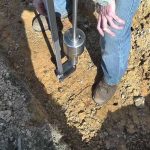Begemann (1965)
Begemann (1965) pioneered soil profiling from the CPT, showing that, while coarse-grained soils generally demonstrate larger values of cone stress, qc, and sleeve friction, fs, as opposed to fine-grained soils, the soil type is not a strict function of either cone stress or sleeve friction, but of the combination of the these values.
Figure 2.2 presents the Begemann soil profiling chart, showing (linear scales) qc as a function of fs. Begemann showed that the soil type is a function of the ratio, the “friction ratio”, fR, between the sleeve friction and the cone stress, as indicated by the slope of the fanned-out lines. Table 2.1 shows the soil types for the Begemann data base correlated to friction ratio. The Begemann chart and table were derived from tests in Dutch soils with the mechanical cone. That is, the chart is site-specific, i.e., directly applicable only to the specific geologic locality where it was developed. For example, the cone tests in sand show a friction ratio smaller than 1 %. A distinction too frequently overlooked is that Begemann did not suggest that the friction ratio alone governs the soil type. Aspects, such as overconsolidation, whether a recent or old sedimentary soil, or a residual soil, mineralogical content, etc. will influence the friction ratio, and, therefore, the interpretation, as will a recent fill or excavation. It is a mistake to believe that the CPTU can duplicate the sieve analysis, or replace it in a soils investigation.


Sanglerat et al. (1974)
Sanglerat et al. (1974) proposed the chart shown in Fig. 2.3A presenting cone stress, qc , (logarithmic scale) versus sleeve friction from soundings using a 80 mm diameter research penetrometer. Figure 2.3B shows the same graph but with the cone stress in linear scale. The green curves indicate the range of values ordinarily encountered. The change from Begemann’s type of plotting to plotting against the friction ratio is unfortunate. This manner of plotting has the apparent advantage of combining the two important parameters, the cone stress and the friction ratio. However, plotting the cone stress versus the friction ratio implies, falsely, that the values are independent of each other; the friction ratio would be the independent variable and the cone stress the dependent variable. In reality, the friction ratio is the inverse of the ordinate and the values are patently not independent—the cone stress is plotted against its own inverse self, multiplied by a variable that ranges, normally, from a low of about 0.01 through a high of about 0.07.

As is very evident in Fig. 2.3, regardless of the actual values, the plotting of data against own inverse values will predispose the plot to a hyperbolically shaped zone ranging from large ordinate values at small abscissa values through small ordinate values at large abscissa values. The resolution of data representing fine-grained soils is very much exaggerated as opposed to the resolution of the data representing coarsegrained soils. This is made obvious in the right graph, which has the cone stress shown in linear scale. Simply, while both cone stress and sleeve friction are important soil profiling parameters, plotting one as a function of the other distorts the information. Obviously, plotting against the Friction Ratio restricts the usable area of the graph, and, therefore, the potential resolution of the test data.
Notice, however, that Fig. 2.3 defines the soil type also by its upper and lower limit of cone stress and not just by the friction ratio. The boundary between compact and dense sand is usually placed at a cone stress of 10 MPa, however.. From this time on, the Begemann manner of plotting the cone stress against the sleeve friction was discarded in favor of Sanglerat’s plotting cone stress against the friction ratio. However, this development—plotting the cone stress against itself (its inverted self) modified by the sleeve friction value—is unfortunate


